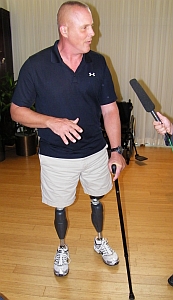An advocacy group kicked off a national media campaign to boost what the group says is flagging public support for biomedical research, focusing on the benefits to military veterans. However, the group’s own poll and other survey data suggest a sizable majority of Americans continues to support public funding of biomedical research.
The Foundation for Biomedical Research (FBR), a public advocacy organization, says the $500,000 campaign is needed in light of a recent Zogby International online poll for the organization showing public support for biomedical research waning. An FBR news release today says support among Americans for biomedical research has dropped to 56 percent, from 70 percent during the Vietnam era (no year given).
FBR made a copy of the survey findings available to Science Business, and the question asked of the poll’s respondents has a significant qualification. The actual wording of the survey question asks, “do you agree or disagree with medical and scientific research that requires lab animals?” The 56 percent cited in the release are the combination of those who somewhat (30%) or strongly (26%) agree. A top issue for FBR in recent years has been building public support for the humane use of animals in medical research.
In a follow-up question asking what respondents find the most disturbing about medical and scientific research, about a quarter (26%) said “nothing”, another quarter (24%) selected the role of pharmaceutical companies, while less than two in 10 selected “the use of animals in research” (18%), and “the use of taxpayer dollars” (16%).
The relatively low opposition to taxpayer funding for medical and scientific research also comes up in a CBS/New York Times survey (archived in Polling Report) conducted in January 2011. The national telephone sample was asked:
“If you HAD to choose ONE, which of the following domestic programs would you be willing to reduce in order to cut government spending: education, OR roads, bridges and other infrastructure, OR science and medical research, OR aid to the unemployed and poor?”
About a third (34%) selected roads and bridges, a quarter (26%) said science and medical research, about a fifth (21%) said aid to the unemployed and poor, and eight percent chose education.
Wounds, visible and invisible
The FBR news conference today in Washington, D.C. suggests FBR is broadening its focus from solely the use of animals in research. The event called attention to the benefits of research to military veterans needing advanced prosthetic devices to replace lost limbs or suffer less visible wounds from traumatic brain inury and post-traumatic stress disorder (PTSD).
Regina Armstrong, director of the Center for Neuroscience and Regenerative Medicine (CNRM) at the Uniformed Services University for the Health Sciences, described research underway at that facility on traumatic brain injury and PTSD. CNRM, said Armstrong, conducts lab and clinical studies involving pathology and neuro-imaging.
The pathology studies help show parallels between head traumas encountered by both military service people and civilians. CNRM’s neuro-imaging capabilities, Armstrong added, include a dedicated MRI for head scans, which she says is needed because mild traumatic brain injuries do not always show up in routine CAT scans.
Lt. Colonel Timothy Karcher (pictured at top), an active-duty U.S. Army officer who lost both his legs above the knee to a roadside bomb in Iraq in June 2009, described and demonstrated his advanced prosthetic devices, made by device manufacturer Otto Bock. His artificial limbs with knee joints, made of a lighter carbon fiber material, contain microprocesors and gyro-electronics to enable a more natural walking motion, including climbing stairs.
Karcher cited the public investment in his rehabilitation that made it possible for him to remain in the Army. “I’m wearing 80 to 100 thousand dollars in legs right now,” said Karcher.
Actor Robert David Hall, who appears as pathologist Albert Robbins in the CBS television series CSI, Crime Scene Investigation, like Karcher, also lost both of his legs above the knee, in a traffic accident in 1978. Hall described the different prostheses he wore since that time, beginning with hand-carved wooden legs to more advanced devices he wears today.
Hall underscored the need for public support for people with disabilities. “Soft music doesn’t follow us around,” said Hall, calling for the public to accept people with disabilities as “whole people” who can function in many professions and industries. Karcher added that the idea of disability is attitudinal as well as physical. “You’re only as disabled as you want to be,” said Karcher.
Read More: Self-Powered Prosthetic Leg Developed, Patented, Licensed
* * *


 RSS - Posts
RSS - Posts
Sir, Good on ya. Been a hwile since we chatted hope. Currently deployed, my best wishes to your family, you look great keep going. -Smitty